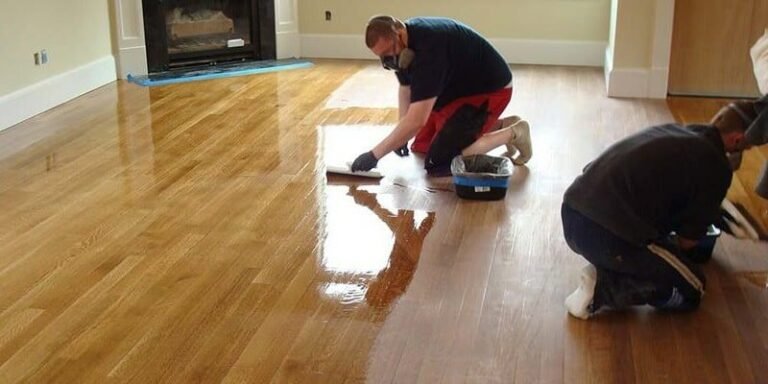If you’ve ever learned about low VOC flooring, you may be cognizant of some of the chemicals commonly used in flooring. Some bamboo flooring even contains formaldehyde, which is obviously something we don’t want to inhale. While bamboo is one of the more sustainable wood flooring options, it’s still not guaranteed to be completely VOC-free, so wear plenty of personal protective equipment (PPE) and keep dust under control when doing cleanup.
Now that we’ve addressed that, let’s move on to the actual process.
II. Required Items
(i) Personal protective equipment (PPE)
Goggles, dust mask, ear protection, gloves.
(ii) Tools
Drum sander, orbital sander, putty knife, paintbrush or applicator, cleaning rags, vacuum cleaner.
(iii) Materials
Coarse grit sandpaper (60 grit), medium grit sandpaper (80 – 100 grit), fine grit sandpaper (120 – 150 grit, 220 grit), wood filler, wood stain (optional), polyurethane finish.
(iv) Miscellaneous
Plastic sheeting for covering vents and doorways.
III. Operation Steps
(i) Preparation stage
First, remove all furniture, carpets and other items from the room to ensure a clean workspace. It is important to cover vents, doorways and other openings with plastic sheeting to prevent dust from spreading throughout your home.
After cleaning the room, sweep and vacuum the floor thoroughly to remove dust and debris. For a more thorough cleaning, mop the floor with a damp cloth and allow it to dry completely.
Check the floor for any protruding nails or staples and hammer them down or remove them to avoid damaging the sanding equipment.
(ii) Sanding the floor
Start with a drum sander for sanding large areas of floor.
Attach coarse sandpaper (approximately 60 grit) to the drum sander to remove the old surface as well as any surface imperfections. Move the sander slowly and steadily in the direction of the bamboo grain to avoid uneven patches.
Use an orbital sander for edges, corners and tight spaces that cannot be reached by the drum sander. Follow the same sanding direction and technique.
After the initial sanding, switch to medium grit sandpaper (80 – 100 grit) and sand the entire floor again. This step further smooths the surface and removes any residual finish. Finish the sanding process with fine grit sandpaper (120 – 150 grit) to achieve a smooth, even surface.
Make sure to sand the floor evenly and thoroughly for best results.
(iii) Filling gaps and cracks
Check the sanded floor for gaps or cracks. Use a high quality wood filler to fill these imperfections.
Apply the filler wood with a putty knife, pressing it firmly into the gaps or cracks to ensure complete filling. Follow the manufacturer’s instructions and allow the filler to dry before proceeding to the next step.
(iv) Staining the floor (optional)
If you wish to change the color of your bamboo flooring, you can apply a wood stain at this time. Apply the stain with a brush or cloth, working in small sections and following the direction of the bamboo grain.
Always follow the manufacturer’s instructions, including the method of application and drying time. Allow the stain to dry completely before proceeding to the final treatment step.
(v) Applying the finish
Once the floor has been sanded and stained (if desired), it’s time to apply a protective finish. Polyurethane is a popular choice due to its durability and ease of use.
First, gently stir the polyurethane to avoid air bubbles. Using a quality brush or applicator, apply a thin, even coat of polyurethane to the floor. Work in small sections and follow the direction of the bamboo grain to ensure a smooth surface.
Allow the first coat of polyurethane to dry completely, this usually takes a few hours or overnight depending on the product used.
Once dry, lightly sand the floor with fine sandpaper (220 grit) to remove any imperfections or air bubbles. Before applying the next coat, wipe the floor with a clean, damp cloth to remove dust.
Repeat the application and sanding of at least two or three coats of polyurethane, allowing each coat to dry completely before applying the next. This multi-coat method ensures a durable, long-lasting finish.
(vi) Final touches
After the final coat of polyurethane has dried, clean the floor to remove any dust or debris. Re-arrange any previously removed furniture and enjoy your newly refinished bamboo flooring.


